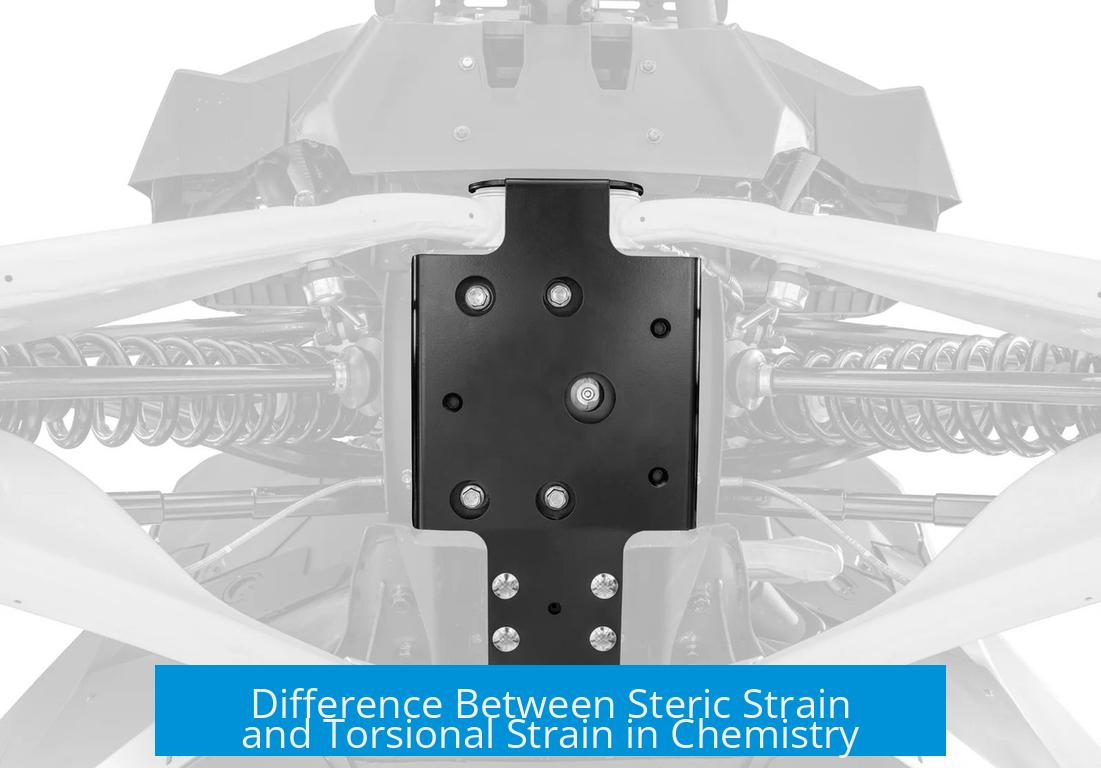Understanding the Difference Between Steric Strain and Torsional Strain

Steric strain and torsional strain are two types of molecular strain arising from repulsive interactions, but they differ in origin and context of occurrence. Torsional strain happens due to repulsion between bonds on adjacent atoms, especially when these bonds eclipse each other. Steric strain arises from repulsion between larger groups or substituents forced into close contact.
What Is Torsional Strain?
Torsional strain occurs from bond-to-bond repulsion between electrons in bonds on neighboring atoms when these bonds are eclipsed rather than staggered. This strain increases the molecule’s energy, making certain conformations less favorable.
- Commonly seen in eclipsed conformations of ethane and its derivatives.
- Appears during rotation around a single bond when atoms align their bonds instead of staggering them.
What Is Steric Strain?
Steric strain is due to group-to-group repulsion when bulky substituents approach too closely. The physical crowding causes destabilization from electron cloud overlap beyond simple bond interactions.
- Occurs when large substituents or groups are forced near one another.
- Common in crowded cycloalkanes and substituted alkanes with bulky groups.
When Do These Strains Occur?
| Strain Type | Origin of Repulsion | Typical Occurrence |
|---|---|---|
| Torsional Strain | Bond-to-bond electron repulsion | When adjacent bonds eclipse during rotation (e.g., ethane eclipsed conformation) |
| Steric Strain | Spatial crowding of groups or substituents | When bulky groups get physically close (e.g., substituted cycloalkanes with large substituents) |
Summary
Torsional strain impacts molecular stability through electron repulsion along bonds that eclipse each other. Steric strain influences conformation by forcing large groups into spatial conflict. Both strains raise the energy of molecules but stem from distinct types of repulsive interactions.
- Torsional strain involves electronic repulsion between bonds on adjacent atoms.
- Steric strain involves physical crowding of bulky substituents or groups.
- Torsional strain changes with bond rotation alignment; steric strain depends on spatial group size and proximity.
What is the main difference between steric strain and torsional strain?
Torsional strain arises from the repulsion between bonds on adjacent atoms when they are eclipsed. Steric strain comes from the physical crowding of larger groups within a molecule, causing repulsion between those groups.
When does torsional strain typically occur in a molecule?
Torsional strain happens when bonds on neighboring atoms are forced into an eclipsed conformation. This increases energy due to bond-to-bond repulsion, like in ethane when rotating around a single bond.
In what molecular situations does steric strain arise?
Steric strain occurs when bulky substituents or groups are pushed too close. This crowding causes repulsion beyond just bond alignment, often seen in crowded cycloalkanes or molecules with large side groups.
Can steric strain and torsional strain happen simultaneously?
Yes, both strains can occur at once. For example, bulky groups in eclipsed positions can cause torsional strain from bond repulsion and steric strain from group crowding. Both add to molecular instability.
How do steric and torsional strain affect the stability of molecules?
Both strains increase a molecule’s energy and reduce stability. Torsional strain raises energy by forcing bonds to eclipse, while steric strain increases repulsion by pushing large groups together.




Leave a Comment